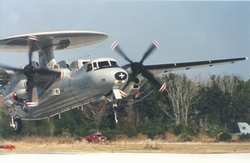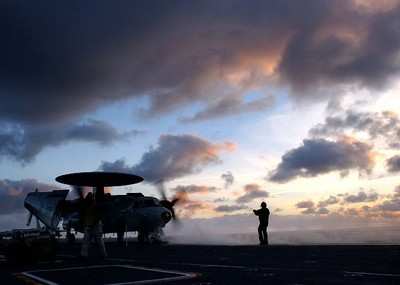Becomes Operational In 2011
 The Naval Air Systems Command today
announced that the Advanced Hawkeye, the Navy’s next
carrier-based tactical battle management, airborne early warning
and command and control aircraft, will officially be designated the
E-2D.
The Naval Air Systems Command today
announced that the Advanced Hawkeye, the Navy’s next
carrier-based tactical battle management, airborne early warning
and command and control aircraft, will officially be designated the
E-2D.
A follow-on to the E-2C Hawkeye 2000 (right) in combat service
today, the E-2D Advanced Hawkeye will serve as a key node in
network centric operations, and will play a vital role in the
Navy’s transformational Sea Strike and Sea Shield operating
concepts. Currently under development by NAVAIR and the Advanced
Hawkeye industry team, the E-2D is expected to have an initial
operating capability in 2011.
Advanced Hawkeye will build on the E-2C’s current network
centric capabilities, plugging into the global information grid
that will connect resources in and outside of the theater of
battle. The Navy will employ the E-2D for maritime, littoral and
overland operations.
Advanced Hawkeye will benefit from a new, higher-power rotating
UHF radar antenna, the ADS-18 electronically scanned array. The
E-2D’s longer detection range and smaller target
discrimination will extend the platform’s traditional roles
to include theater air missile defense.
Other advances in the E-2D design include a tactical cockpit
with three 17-inch LCD primary flight displays; navigation systems
upgrades; an improved communications suite; advanced combat
information center and mission data processing; and the digitally
controlled NP2000 eight-bladed rotor system.
The first version of the E-2C Hawkeye, which has already seen
four expansions of its capabilities prior to Advanced Hawkeye,
became operational in 1973. In the 1980s, Hawkeyes directed naval
aviation forces flying combat air patrol during strikes against
terrorist-related Libyan targets. In the 1990s, E-2s provided
airborne command and control for successful coalition air
operations during Operation Desert Storm, Operations Northern and
Southern Watch over Iraq, and NATO operations over the former
Republic of Yugoslavia.
Recently in Operations Enduring Freedom and Iraqi Freedom, E-2
Hawkeyes provided critical airborne battle management and command
and control functions supporting close air support and battlefield
air interdiction missions.

The E-2D Advanced Hawkeye will be a powerful resource in the
Navy’s transformational Sea Strike offensive capabilities,
increasing battlespace awareness, improving detection and tracking,
and shortening the link between sensor and shooter for more agile
response to time-sensitive targets. At the same time, the Advanced
Hawkeye will cast a protective umbrella over air, sea and land
forces, serving as a crucial pillar in the Sea Shield
construct.
NAVAIR provides advanced warfare technology through the efforts
of a seamless, integrated, worldwide network of aviation technology
experts. From professional training to carrier launch; from sensor
data to precision targeting; from aircraft and weapons development
to successful deployment; from real-time communication to aircraft
recovery, NAVAIR provides dominant combat effects and matchless
capabilities to the American warfighter.
 ANN's Daily Aero-Linx (05.02.24)
ANN's Daily Aero-Linx (05.02.24) ANN's Daily Aero-Term (05.02.24): Touchdown Zone Lighting
ANN's Daily Aero-Term (05.02.24): Touchdown Zone Lighting Aero-News: Quote of the Day (05.02.24)
Aero-News: Quote of the Day (05.02.24) ANN FAQ: Contributing To Aero-TV
ANN FAQ: Contributing To Aero-TV NTSB Final Report: Cirrus Design Corp SR20
NTSB Final Report: Cirrus Design Corp SR20




